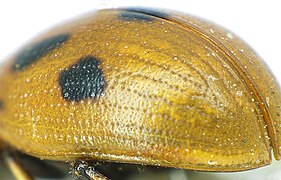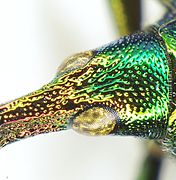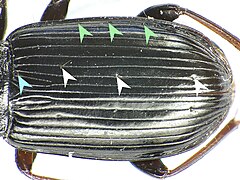Dotting (entomology)
In entomology, puncture or puncture (from late Middle High German punctierunge or late Latin : punctura = the stinging) is understood as a certain surface structure of the exoskeleton of insects , in which this has point-like depressions. The individual indentations are called points (from the Latin "punctum" for "stitch, point"). A surface with a puncture is called dotted or dotted . If the surface is smooth or sculpted in some other way (for example, wrinkled, grained or shagreened, i.e. covered with a fine pattern of polygonal meshes) it is called unpunctured.
Differentiation from similar terms
In English, “puncture” is used in another sense besides the meaning described here as a point. The term is used for piercing or punctiform gnawing of animal or vegetable tissue and its result. The perforation of the surface for the purpose of ingesting food is called, for example, “feeding puncture” that for laying eggs “oviposition puncture”; also with certain insects there is a piercing of the females for the purpose of mating.
The connections with the root word “punct” that appear in scientific names, which are often adopted in the German trivial names (example Coccinella septem punct ata seven- point ladybug ) designate flat, color-highlighted spots that are far larger than the points of the puncture. Larger, rounded depressions, on the other hand, are called “pits” (Fig. 13).
General
The puncturing is genetically determined. It varies individually, but only insignificantly. Basic properties of the puncturing are constant within an insect species . The type of puncturing therefore plays an important role in the description of systematic units, especially of species. Since the puncture wears little with the age of the insect, it can also be used for determination in older animals - in contrast to the hair, for example.
Because of the good constancy of the puncture, the puncturing of a part of the body of a certain species could be described fairly precisely, for example by the approximate number of points per unit area, the size of the point diameter and the way they are distributed. In the history of entomology, however, after the brief initial descriptions, attention was mainly directed to the delimitation of similar species from one another. That is why one finds almost exclusively relative descriptions such as "denser - less dense" or "coarse - fine" in the literature.
Since the points are usually much smaller than a millimeter in diameter, the puncture can usually only be examined more precisely with the help of a magnifying glass, a binocular or a microscope. This is often associated with the use of an artificial light source. It should be noted that the subtleties of the puncture are only recognized with small movements of the object, slight changes in the depth of field and change in the direction of the incidence of light with a corresponding movement of the shadow. That is why two-dimensional photos can only be interpreted in three dimensions with practice. For example, by folding down the spatial impression, depressions can appear as elevations.
Types of puncturing
Fig. 1: Regular stripes of Helophorus grandis
Fig. 2: Irregular stripes Gonioctena fornicata
Fig. 3: Diffuse puncture leg of Scaurus sp.
Fig. 4: Dense, coarse puncture Agapanthia cardui
Fig. 5: Rasp- like puncture
Onthophagus verticicornisFig. 6: Fine puncture Gonioctena fornicata
Fig. 7: Umbilical points of the head of Platydracus stercorarius
Fig. 8: Deeply pierced points of the wing cover Stenostola dubia
Fig. 9: Wrinkled puncture forehead Byctiscus betulae
Fig. 10: Double puncture, increasing flattening of the coarse points towards the rear, wing cover of Aegomorphus clavipes
Fig. 11: Certallum ebulinum , puncture unequal density
> Fig. 12: Aegomorphus clavipes pore points
Fig. 13: Pit wing cover Carabus rutilans
Fig. 14: Double puncture
Coprimorphus scrutator
The puncturing can be classified according to different aspects, for example according to the arrangement of the points, their size and density and their appearance.
Arrangement of points
Very often, especially on the wing covers of the beetles , the points are arranged in rows that run more or less parallel to the wing cover seam . Such rows are called stripes (Latin striae, singular stria). They can be regular (straight, Fig. 1) or somewhat irregular (diffuse rows, Fig. 2). In the other case, the puncture is called disordered or diffuse (Fig. 3).
Density of points
In one extreme the points are close (crowded) or very close together, in the other they are scattered or isolated. In the case of dense points, a distinction is often made as to whether the distance between the points is larger, the same or smaller than the diameter of the points. The density of the points often varies in a characteristic way. For example, the points on the disk of the pronotum can be dense and increasingly scattered towards the edge. In the case of both scattered and dense points, the distances between the points can either be approximately the same or there are points that are closer or less close together (Fig. 14). In the case of dense points with approximately the same distance, one speaks of a reticulated puncture. For example, in Fig. 4 the puncture is dense, on the pronotum (above) a little denser than on the elytra (below). And in Fig. 11 the pronotum is not uniformly dotted with the same density, but the elytra is.
Type of each point
Large individual points are usually referred to as coarse puncture (Fig. 4), while small points are referred to as fine puncture (Fig. 6). With a fine puncture, you differentiate whether it can still be seen with the naked eye or only when magnified. The latter can also be described as "apparently unpunctivated". There is double puncturing if the size of the points can be clearly assigned to two size classes. As a rule, one only notices the large dots at first, and on closer inspection the small dots in between (Fig. 14 also clearly recognizable in Fig. 10b). Very fine dots are sometimes described as "dotted".
In the simplest case, the points have the shape of an impression, such as that left by a ball in the sand (Fig. 1). However, points can also be flat (Fig. 3) or deep (strong, deeply pierced, Fig. 8). In Fig. 10 the large points flatten from A to D (A near the base, D near the end of the wing cover).
In addition, the impression does not have to be round. In the case of elongated impressions, both ends can be rounded, or one side tapers to a point (teardrop-shaped) or both sides are pointed. In Fig. 9 you can see different transitions from round to wrinkled points. In rare cases, the rounded point also has several tapering corners, such as a bomb crater. The edges of the points can be raised to a hump or point on one side so that the point is rasp-like (Fig. 11 5). The puncture is called nicked , if the individual point has a ring wall inside or resembles a gap opening on the leaf of a plant.
If a (sensory) hair arises from a point, the point is called a pore point . The fine sensory hairs (trichobothria) are much more difficult to see than the associated pore point. The location of pore points with sensory hair is z. B. very important when determining weaving spiders . A pore point can also be a navel point. The head in Fig. 7 is covered with umbilical points, the white arrow points to an umbilical point, which is also a pore point. The arrows in Fig. 12 point to pore points. These are labeled at the same time.
Bristle points, also called bristle pits or alveoli, are generally points from which a hair, a bristle or a scale originates.
literature
- Stefan von Kéler: Entomological dictionary with special consideration of morphological terminology . 3. Edition. Akademie-Verlag, Berlin 1963 (EA Berlin 1955)
- Heinz Joy, Karl-Wilhelm Harde, Gustav Adolf Lohse (ed.): Die Käfer Mitteleuropas, Vol. 1–11 . Goecke & Evers, Krefeld
- John L. Capinera (Ed.): Encyclopedia of Entomology . Springer Science + Business Media, Dordrecht 2008, ISBN 978-1-4020-6242-1 .
- Armand R. Maggenti et al .: Online Dictionary of Invertebrate Zoology. Complete work . University of Nebraska, Lincoln Neb. 2005.
- José Rollin de la Torre-Bueno: A Glossary of Entomology New York Entomological Society, New York 1985, ISBN 0-913-424-13-7 .
- Lajos Zombori, Henrik Steinmann: Dictionary of Insect Morphology, Vol. 4, Part 34 . De Gruyter, Berlin New York 1999.
Individual evidence
- ↑ Origin of punctuation according to Duden
- ^ Origin of puncture according to Duden
- ↑ José Rollin de la Torre-Bueno: A Glossary of Entomology .
- ↑ Armand R. Maggenti et al .: Online Dictionary of Invertebrate Zoology. Complete work .
- ↑ John L. Capinera (Ed.): Encyclopedia of Entomology .
- ↑ a b Stefan von Kéler: Entomological dictionary with special consideration of the morphological terminology .













